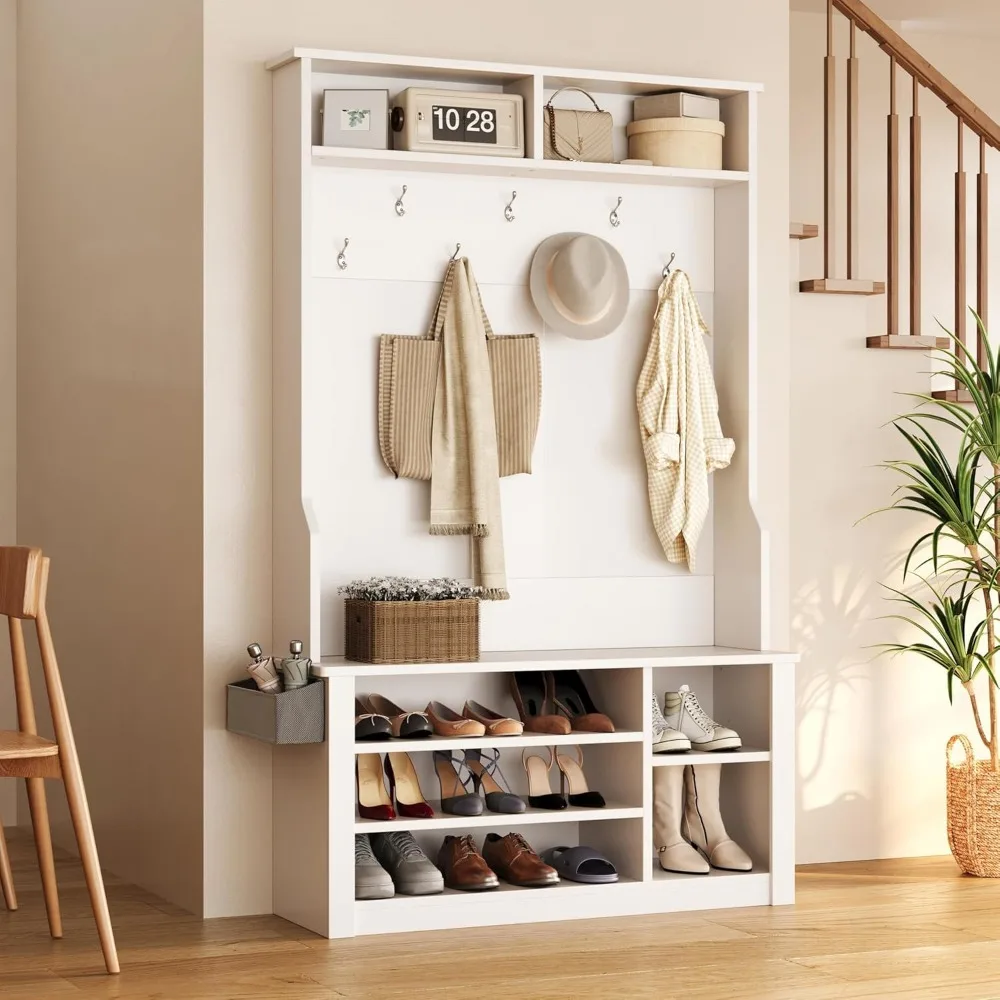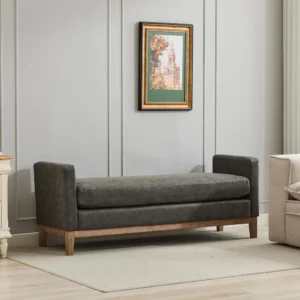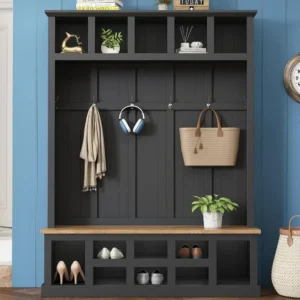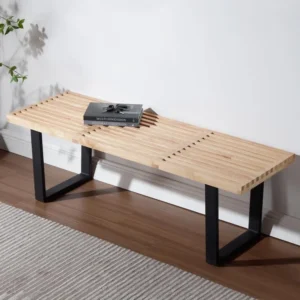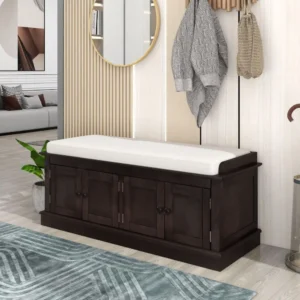Introduction: Understanding the Mudroom Bench
A mudroom bench is a multifunctional piece of furniture designed specifically for entryways and transition spaces in homes. Unlike standard decorative benches, a mudroom bench combines comfortable seating with practical storage solutions to create an organizational hub where family members can prepare to enter or leave the home.
Definition: A mudroom bench is a specialized seating solution with integrated storage features designed for entryways to contain outdoor items, provide seating for removing shoes, and create a boundary between the outdoors and your clean home interior.
What sets mudroom benches apart from regular benches is their deliberate focus on functionality. While a standard bench might offer seating alone, a proper mudroom bench integrates storage compartments, hooks, and organizational features specifically designed to manage the clutter that accumulates at home entrances.
As modern homes evolve, functional mudroom seating solutions have become increasingly important transition zones that help maintain order and cleanliness. These practical pieces serve as the first line of defense against outdoor elements, creating a clear boundary that prevents dirt, mud, and clutter from spreading throughout your home. The growing popularity of mudroom benches reflects our increasing desire for organized, functional living spaces that simplify daily routines.
The Core Purpose and Functionality of a Mudroom Bench
At its core, a mudroom bench serves as a transition zone between the outdoors and your home’s interior. This seemingly simple piece of furniture fulfills several critical functions that make daily life more organized and efficient.
Key Functions of a Mudroom Bench:
- Transition Spot: Provides a dedicated place to sit while removing or putting on shoes, boots, and outerwear before entering or leaving the home
- Organization Hub: Creates a centralized location for storing frequently used outdoor items like shoes, coats, bags, and accessories
- Clutter Control: Prevents the spreading of outdoor elements (mud, dirt, water) throughout the home
- Efficiency Booster: Streamlines morning routines and arrivals by keeping necessary items visible and accessible
Different households benefit from mudroom benches in unique ways. For families with children, these benches become command centers for managing backpacks, sports equipment, and the inevitable pile-up of shoes. Pet owners appreciate having a designated spot for leashes, towels for muddy paws, and pet accessories. Active individuals find them invaluable for organizing workout gear, hiking equipment, or seasonal sport items.
The functionality of mudroom benches becomes particularly apparent during challenging weather conditions. On rainy days, they provide a place to remove wet shoes and hang dripping umbrellas without tracking water through the house. During snowy winters, they become essential staging areas for managing bulky coats, boots, scarves, and gloves. After sports activities, they offer a contained space for removing dirty cleats and sweaty gear.
Understanding what is a mudroom in a house helps put these benches in context—they’re often the centerpiece of these transitional spaces. The most effective multi-functional mudroom benches combine seating, storage, and organization in ways that directly address your household’s specific patterns and needs.
Key Benefits of Incorporating a Mudroom Bench
Adding a mudroom bench to your home offers numerous advantages that extend far beyond simple storage. Here are the most significant benefits you’ll experience:
Improved Home Organization and Reduced Clutter
A mudroom bench creates a designated “drop zone” for items that would otherwise be scattered throughout your home. When everything from keys to backpacks has a specific storage place, clutter disappears almost automatically. Families who implement mudroom benches often report dramatic reductions in the “where are my shoes?” morning chaos.Enhanced Cleanliness and Hygiene
By providing a transition area where outdoor elements stay contained, mudroom benches significantly reduce the spread of dirt, debris, and germs throughout your home. This containment means less frequent cleaning of your main living areas and improved overall home hygiene.Increased Convenience and Daily Efficiency
The average person spends several minutes each day searching for misplaced items. A well-organized mudroom bench eliminates this wasted time by keeping frequently used items visible and accessible. Many users report saving 5-10 minutes on hectic mornings simply by having a designated place for essential items.Added Functional Seating in High-Traffic Areas
Beyond storage, the seating component of mudroom benches provides practical value multiple times daily. This becomes particularly important for elderly family members or anyone who needs support when putting on or removing footwear.Boosted Home Aesthetics and Potential Value
A thoughtfully designed mudroom bench enhances your home’s appearance while adding functional value. Real estate professionals note that organized entryway solutions like mudroom bench shoe storage can positively impact potential buyers’ impressions and may contribute to higher resale values.
Studies have shown that organized environments reduce stress hormones and improve mental clarity. By creating a systematic approach to managing everyday items, mudroom benches contribute to more peaceful home environments where family members spend less time searching and more time enjoying their space.
Essential Features and Components of a Mudroom Bench
The effectiveness of a mudroom bench depends largely on its specific components and how they work together to meet your needs. Understanding these key elements will help you select or design the perfect solution for your home.
Seating Area
The bench seat forms the foundation of any mudroom bench. Key considerations include:
- Comfort: Look for seats with adequate width (typically 15-18 inches/38-46 cm) and supportive surfaces
- Durability: Seats should withstand repeated daily use and the weight of adults
- Height: Standard seating height of 17-19 inches (43-48 cm) ensures comfortable use for most adults
- Edge design: Slightly rounded edges prevent discomfort during extended sitting
Storage Solutions
The storage components determine how functional your mudroom bench will be:
- Open Cubbies: Provide visible, accessible storage for shoes and baskets
- Drawers: Offer concealed storage for smaller items like gloves, scarves, and accessories
- Lift-Top Storage: Creates hidden storage under the seat for seasonal items or rarely used gear
- Shoe Compartments: Specialized spaces with proper ventilation and sometimes angled designs for footwear
- Shelving: Additional open storage above or below the seating surface for baskets or frequently used items
Hooks and Hanging Space
Vertical storage is crucial for maximizing organization:
- Coat Hooks: Typically positioned 54-64 inches (137-163 cm) from the floor
- Key Hooks: Smaller hooks at convenient reaching height for quick access items
- Configuration Options: Single row, double row, or staggered arrangements depending on your space and needs
Common Materials
The materials used in construction affect both aesthetics and durability:
- Wood Options:
- Solid wood (oak, maple, pine): Offers durability and classic appeal with proper sealing
Engineered wood/MDF: Provides affordability and stability with various finish options
Metal Elements:
- Hooks and hardware: Often in brushed nickel, matte black, or oil-rubbed bronze
Support structures: Steel frameworks provide additional strength for heavier loads
Upholstery Options:
- Performance fabrics: Stain-resistant materials ideal for high-traffic areas
- Vinyl/leather: Wipeable surfaces that stand up to moisture and dirt
- Removable cushions: Allow for cleaning and seasonal changes
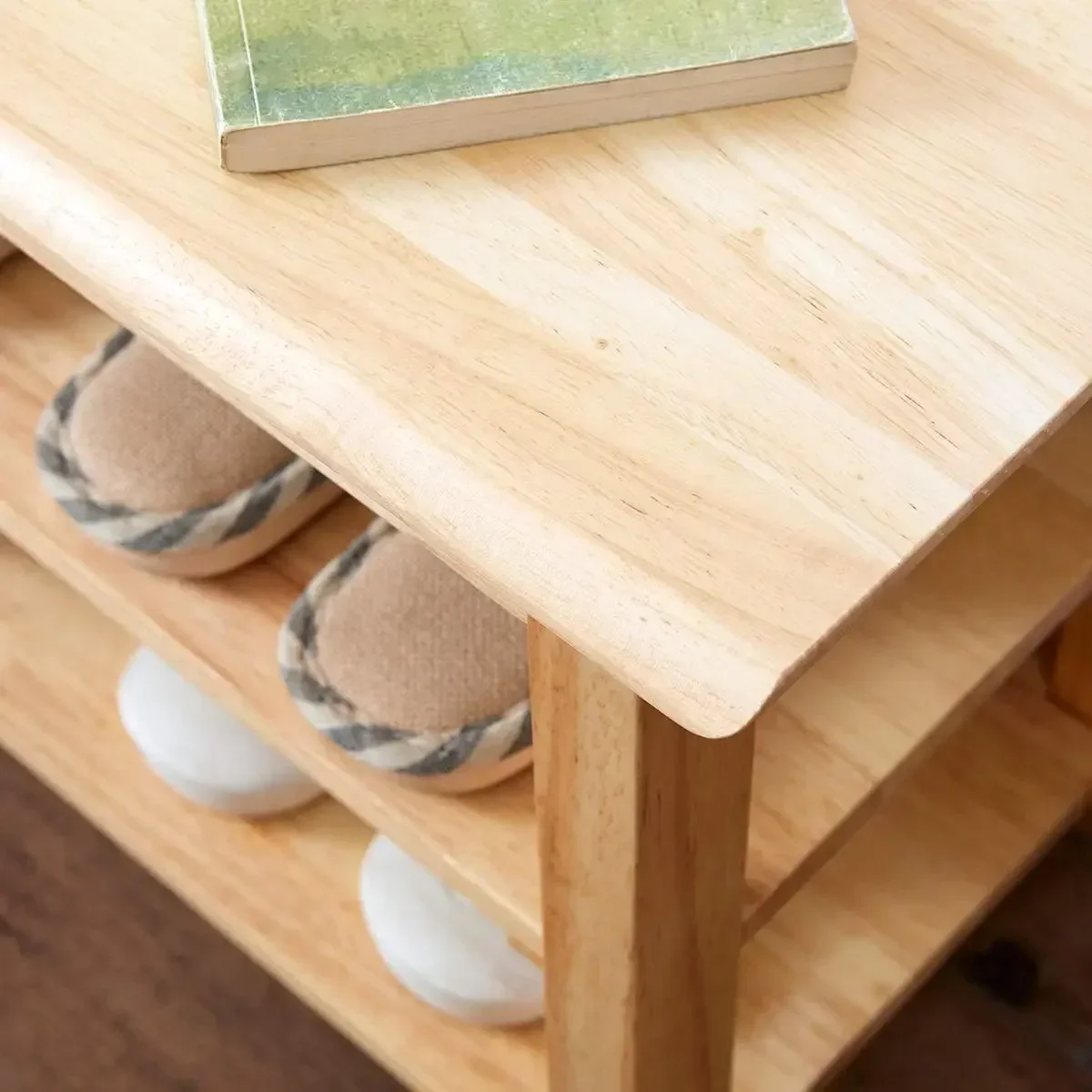
Back Panel Variations
The back panel serves both functional and aesthetic purposes:
- Solid Panels: Provide a finished look and prevent items from falling behind the unit
- Beadboard/Shiplap: Adds texture and traditional styling
- Open Framework: Creates a lighter visual footprint in smaller spaces
Wood mudroom benches remain particularly popular for their warmth and natural aesthetic appeal, though the specific type of wood should be selected based on your durability needs and existing home decor.
Types and Styles of Mudroom Benches
Mudroom benches come in various configurations and aesthetic styles to suit different spaces and personal preferences. Understanding these options helps you select the perfect bench for your home.
Configuration Types
Freestanding Benches
These standalone units offer maximum flexibility and can be repositioned as needed. They’re ideal for renters or those who may want to reconfigure their space later. Freestanding benches typically range from 36-60 inches (91-152 cm) in width and can be placed against any wall.
Built-in Benches
Custom-integrated into your home’s architecture, built-ins maximize space efficiency and create a seamless look. These benches utilize wall cavities and corners for a perfect fit, though they require more investment and become a permanent fixture.
Hall Trees
These comprehensive units combine a bench with a tall framework featuring hooks and sometimes cabinets or shelves above. Hall trees are excellent for homes lacking a dedicated mudroom as they provide complete organization in a single piece.
Corner Benches
Designed specifically for corner placement, these L-shaped units maximize otherwise awkward spaces. They’re particularly valuable in smaller homes where every square inch matters.
Floating Benches
Wall-mounted without legs, floating benches create a modern, space-efficient solution that leaves floor space open for easy cleaning and a more spacious appearance.
Benches with Upper Storage
These designs extend storage vertically with cabinets or shelving above the bench, utilizing wall space effectively in homes with limited square footage.
Aesthetic Styles
Farmhouse
Characterized by rustic wood, distressed finishes, and simple functional design, farmhouse-style benches bring warmth and casual comfort to entryways. These pieces often feature beadboard backs and cup or bin-style hardware.
Modern/Contemporary
Clean lines, minimalist design, and mixed materials define modern mudroom benches. Look for smooth surfaces, hidden hardware, and combinations of wood with metal or glass elements.
Traditional
Featuring classic design elements like crown molding, raised panels, and turned legs, traditional benches offer timeless appeal that works well in heritage homes or established neighborhoods.
Rustic
Emphasizing natural materials, visible wood grain, and sometimes reclaimed elements, rustic benches celebrate imperfections and create a cozy, cabin-like atmosphere.
Coastal/Nautical
Light colors, weathered finishes, and sometimes rope or navy blue accents characterize these breezy, relaxed pieces that evoke beachfront living.
Shaker-Style
Defined by simple, functional design with minimal ornamentation, Shaker-style benches offer clean lines and exceptional craftsmanship that complements many home styles.
The mastering mudroom best bench styles approach suggests selecting a configuration based on your space constraints and functionality needs first, then choosing an aesthetic style that complements your existing decor. For homes with traditional farmhouse elements, a farmhouse mudroom bench creates a cohesive look while providing necessary organization.
Finding the Perfect Size: Dimensions and Space Planning
Selecting the right-sized mudroom bench ensures both comfort and functionality. Here’s what to consider when determining the ideal dimensions for your space.
Standard Measurements for Mudroom Benches
| Dimension | Small Space | Medium Space | Large Space |
|---|---|---|---|
| Height (seat) | 17-18 in (43-46 cm) | 18 in (46 cm) | 18-20 in (46-51 cm) |
| Overall Height (with hooks) | 60-65 in (152-165 cm) | 65-72 in (165-183 cm) | 72-84 in (183-213 cm) |
| Width | 24-36 in (61-91 cm) | 36-48 in (91-122 cm) | 48-72+ in (122-183+ cm) |
| Depth | 14-16 in (36-41 cm) | 16-18 in (41-46 cm) | 18-20 in (46-51 cm) |
| Clearance Needed in Front | 24-30 in (61-76 cm) | 30-36 in (76-91 cm) | 36-48 in (91-122 cm) |
Key Dimensional Considerations
Seat Height
The standard height of 18 inches (46 cm) accommodates most adults comfortably. For households with elderly members, slightly higher benches (19-20 inches/48-51 cm) can make sitting down and standing up easier.
Width Planning
Consider how many people will likely use the bench simultaneously. Allow approximately 18-24 inches (46-61 cm) of seating width per person. For families, benches under 36 inches (91 cm) may feel cramped during busy morning routines.
Depth Requirements
The bench seat depth must balance comfortable seating with space constraints. While 16 inches (41 cm) is the minimum for comfortable seating, storage benches often extend to 18 inches (46 cm) to accommodate shoes and boots underneath or inside.
Clearance Space
The often-overlooked factor is the space needed in front of the bench. A minimum of 30 inches (76 cm) allows for comfortable use, while 36-48 inches (91-122 cm) is ideal for high-traffic areas where multiple family members might prepare to leave simultaneously.
Understanding what size hallway bench perfect dimensions are for your specific space prevents purchasing a bench that overwhelms smaller areas or looks insignificant in larger spaces. The ideal mudroom bench should feel proportional to its surroundings while providing adequate seating and storage for your household’s needs.
Strategic Placement and Integration in Your Home
Finding the right location for your mudroom bench maximizes its usefulness and enhances your home’s functionality. Consider these strategic placement options and integration principles.
Ideal Locations Throughout the Home
Dedicated Mudrooms
The most obvious placement is within a purpose-built mudroom, typically positioned between an exterior door and the main living areas. This dedicated space allows for comprehensive organization systems built around a central bench.
Main Entryways
Front entryways benefit from slimmer bench designs that create organization without overwhelming the space that visitors first encounter. Consider benches with closed storage to maintain a tidy appearance.
Secondary Entrances
Side and back doors often serve as the family’s primary entry points and benefit significantly from robust mudroom bench setups that can handle daily traffic and activity.
Garage Entrances
The transition point between an attached garage and your home interior is an excellent location for a mudroom bench, as it’s often where family members enter with groceries, work bags, and outdoor gear.
Hallways
Wider hallways can accommodate slimmer bench designs, creating functional stopping points in otherwise underutilized spaces. Look for benches under 16 inches (41 cm) deep to maintain good traffic flow.
Laundry Room Combinations
Combined laundry-mudroom spaces work efficiently with a bench that serves double duty for both folding laundry and removing shoes.
Converted Closet Spaces
Removing closet doors and installing a compact bench with hooks creates a mini-mudroom in spaces as small as 36 inches (91 cm) wide.

Integration Principles
When integrating a mudroom bench, consider these important factors:
- Traffic Flow: Position the bench where it won’t impede natural movement through your home
- Accessibility: Ensure all family members, including children, can easily reach hooks and storage areas
- Visual Harmony: Select a design that complements existing architectural elements and decor
- Lighting: Provide adequate illumination for the space, as dark entryways discourage organization
- Flooring: Choose durable, water-resistant flooring around your bench to handle wet shoes and boots
For homes with limited square footage, space-efficient mudroom bench solutions include wall-mounted options, corner designs, or benches with vertical storage that maximize organization in minimal footprints. These space-saving approaches ensure even compact homes can enjoy the benefits of a dedicated transition zone.
Making the Right Choice: DIY vs. Store-Bought Options
When adding a mudroom bench to your home, you’ll need to decide whether to build your own or purchase a ready-made solution. Each approach offers distinct advantages and challenges.
DIY Mudroom Benches
Advantages:
– Complete customization to fit unusual spaces or specific needs
– Potential cost savings on larger or more complex units
– Ability to match existing woodwork or architectural details exactly
– Personal satisfaction and pride in creating a functional piece
Challenges:
– Requires basic to intermediate woodworking skills
– Necessitates tools like saws, drills, sanders, and measuring equipment
– Time-intensive process (typically 2-5 days for completion)
– May require multiple attempts for perfect results
Material Requirements:
– Lumber (typically 3/4” plywood, 1×3” and 1×4” boards)
– Hardware (hinges for storage lids, hooks, screws, brackets)
– Finishing supplies (paint, stain, polyurethane, sandpaper)
Approximate Cost Range:
– Simple DIY bench: $150-300 in materials
– Complex built-in systems: $300-800+ in materials
Store-Bought Options
Advantages:
– Immediate availability and quick setup
– Professional finish and tested structural integrity
– Warranty protection on most products
– No special tools or skills required
Potential Limitations:
– Standard sizes may not perfectly fit your space
– Limited customization options for unique needs
– Higher cost per square foot than DIY solutions
Price Range Expectations:
– Basic entryway benches: $150-350
– Mid-range mudroom benches with storage: $350-700
– Premium or custom-built units: $700-2,000+
What to Look For:
– Solid construction with screws rather than staples
– Reinforced seating area to support multiple users
– Quality hardware that won’t loosen with repeated use
– Appropriate materials for your household’s activity level
Decision-Making Factors
Consider these questions when deciding between DIY and store-bought:
– How precise are your space requirements?
– What’s your comfort level with tools and construction?
– How quickly do you need the solution implemented?
– What’s your budget for this project?
– How important is a professional finish to your home’s aesthetic?
Understanding mud bench costs helps determine whether the investment in a pre-made bench makes sense for your situation or if allocating time to a DIY project would better serve your needs and budget.
Entryway Bench with Cushion, Mudroom Bench with Cushion, Shoe Bench for Entryway
$1,186.63 Select options This product has multiple variants. The options may be chosen on the product pageCoat Rack Shoe Bench, Corner Entryway Bench, Corner Hall Tree, Shoe Bench for Entryway
$313.58 Select options This product has multiple variants. The options may be chosen on the product pageBench with Hooks and Storage, Entryway Hall Tree, Mudroom Bench with Cubbies, Mudroom Bench with Shoe Storage
$818.38 Select options This product has multiple variants. The options may be chosen on the product pageModern Entryway Bench, Wood Entryway Bench, Wood Mudroom Bench
$497.69 Select options This product has multiple variants. The options may be chosen on the product pageEntryway Coat Rack Bench, Entryway Hall Tree, Farmhouse Mudroom Bench, Mudroom Bench with Shoe Storage
$805.09 Select options This product has multiple variants. The options may be chosen on the product pageEntryway Bench with Cushion, Mudroom Bench with Cabinets, Shoe Bench for Entryway, Shoe Bench with Cushion
$991.71 Select options This product has multiple variants. The options may be chosen on the product page
Related Furniture: Understanding Similar Organizational Solutions
While mudroom benches serve specific organizational needs, several related furniture pieces offer similar functionality with different emphases. Understanding these alternatives helps you select the most appropriate solution for your space and requirements.
Hall Trees
Hall trees represent the most comprehensive entryway organization solution, combining a bench with extensive vertical storage. These pieces typically feature:
– Tall framework with multiple hook levels
– Mirror or decorative backing
– Bench seating with storage underneath
– Sometimes include cabinets or shelving above
Hall trees work particularly well in homes lacking a dedicated mudroom but needing substantial organization. Their all-in-one design makes them ideal for main entryways where both function and appearance matter. The hall trees coat rack benches category offers various configurations combining these elements to create complete entryway systems.
Entryway Benches
Entryway benches emphasize aesthetics alongside basic functionality. Compared to mudroom benches, they typically:
– Feature more decorative elements and refined finishes
– Offer less specialized storage for outdoor items
– Prioritize appearance for formal entryways
– Include design elements like upholstered seats or ornamental legs
These pieces work well in front foyers where first impressions matter but heavy-duty organization isn’t the primary concern.
Storage Benches
As a broader category, storage benches appear throughout homes in various contexts:
– Bedroom benches focus on clothing storage and seating
– Dining benches combine seating with hidden storage
– Outdoor storage benches protect items from elements
While these benches share the basic combination of seating and storage, they lack the specialized organizational features that make mudroom benches effective for entryway use.
Understanding these distinctions helps you determine whether your needs are best served by a purpose-built mudroom bench or if one of these alternatives might better suit your specific situation.
Frequently Asked Questions About Mudroom Benches
What are the most durable materials for a mudroom bench?
For the frame and structure, solid hardwoods like oak, maple, and hickory offer exceptional durability. Engineered wood with quality veneers provides good durability at a lower price point. For bench seats that will see heavy use, look for 3/4-inch or thicker wood construction with reinforcement beneath. Metal frames using steel provide excellent structural support, while metal hooks and hardware should feature powder coating or oil-rubbed finishes to resist corrosion from wet items.
How much should I expect to pay for a quality mudroom bench?
Quality mudroom benches typically range from $300-800 for ready-made options with good construction and features. Basic models with minimal storage start around $150-250, while premium custom-built systems can exceed $1,000. The price increases with additional features like closed cabinetry, specialized shoe storage, and higher-grade materials.
What’s the minimum space needed for an effective mudroom setup?
A functional mudroom area can be created in as little as 3 feet (36 inches/91 cm) of wall space with a depth of 16-18 inches (41-46 cm). However, you’ll need clearance of at least 30 inches (76 cm) in front of the bench for comfortable use. For families, 48-60 inches (122-152 cm) of width provides a more practical setup that accommodates multiple users and adequate storage.
Can I add a mudroom bench if I don’t have a dedicated mudroom?
Absolutely! Many homes successfully incorporate mudroom functionality without dedicated rooms. Consider these approaches:
– Install a hall tree or bench in a wide hallway
– Create an entryway nook by removing a closet door
– Utilize a portion of your laundry room for mudroom functions
– Establish a “drop zone” near your most-used entrance
– Use vertical space with wall-mounted systems in tight areas
How do I maximize storage capacity in a limited space?
To maximize storage in compact areas:
– Choose benches with multiple storage types (cubbies, drawers, and under-seat storage)
– Utilize vertical space with hooks at multiple heights
– Add baskets or bins to organize smaller items
– Install floating shelves above the bench
– Select slimmer bench designs (14-16 inches/36-41 cm deep) that offer functionality without protruding too far into the room
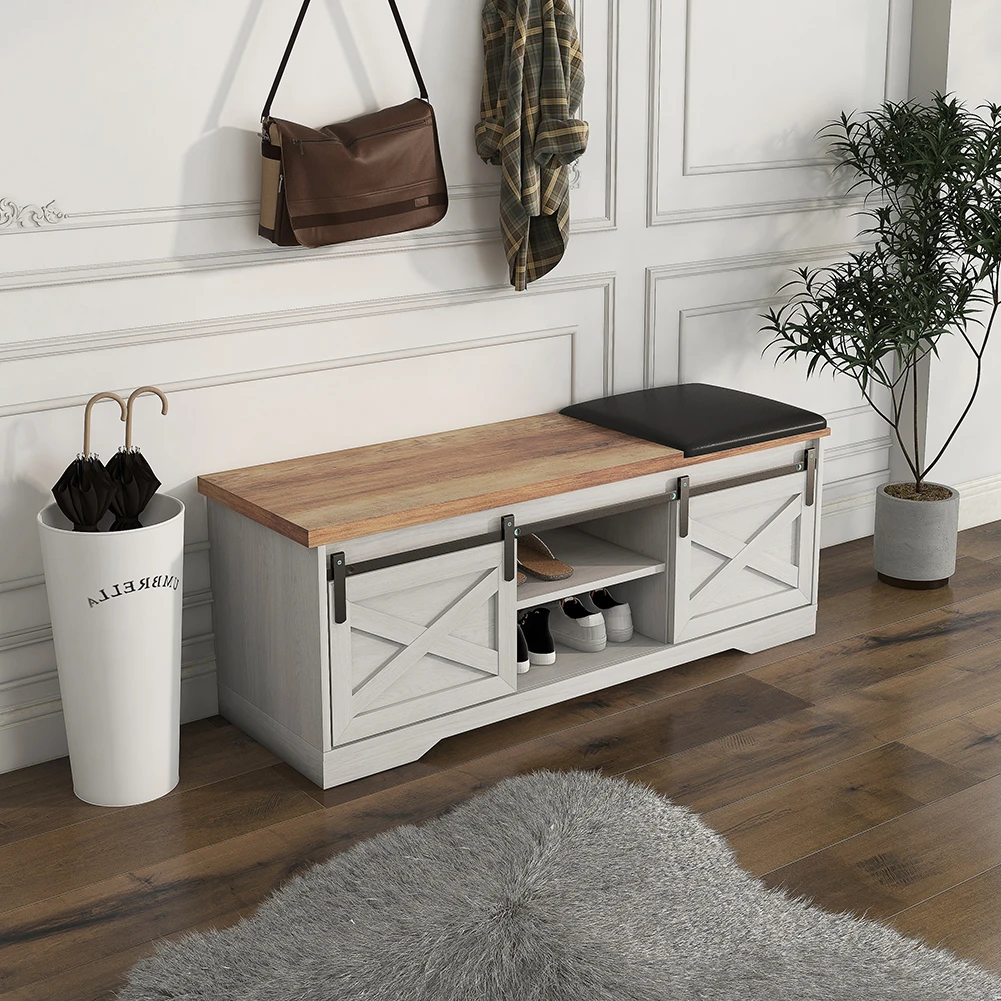
Should mudroom benches be secured to the wall?
Tall hall tree-style benches and floating benches should always be secured to wall studs for safety. Freestanding benches under 30 inches (76 cm) tall generally don’t require anchoring unless they have a high center of gravity or will be climbed on by children. When in doubt, securing furniture to the wall prevents tipping accidents, particularly in households with young children.
What’s the best way to keep a mudroom bench clean and maintained?
For wooden benches, dust regularly and clean with a slightly damp cloth, followed by a dry cloth. Apply furniture polish or wood conditioner 2-3 times yearly to maintain the finish. For upholstered sections, vacuum regularly and treat stains immediately with appropriate cleaners. Metal components should be wiped down to prevent moisture buildup, particularly during wet seasons. Place machine-washable rugs or mats in front of the bench to catch dirt and moisture before they reach your furniture.
For additional insights on creating complete entryway systems, the designing functional mudroom complete guide offers comprehensive planning advice for spaces of all sizes.
Updating Your Entryway: Style Trends and Innovations
Mudroom bench design continues to evolve with changing lifestyles and interior design trends. Staying informed about these developments can help you select a piece that remains functional and stylish for years to come.
Current Style Trends
Today’s mudroom bench designs are embracing several notable trends:
- Two-Tone Finishes: Contrasting colors for the base and top create visual interest while hiding wear in high-traffic areas
- Industrial Elements: Metal accents and framework combined with wood create durable, contemporary appeal
- Minimalist Profiles: Cleaner lines and less ornate details align with modern interior preferences
- Natural Materials: Rattan, woven fibers, and natural wood tones bring organic warmth to entryways
- Multi-Functional Designs: Benches that transform or serve multiple purposes beyond traditional storage
Innovative Features
Manufacturers are incorporating clever innovations to enhance mudroom bench functionality:
- Charging Stations: Built-in USB ports and power outlets for charging devices near entryways
- Ventilated Shoe Storage: Enhanced airflow systems that reduce odors and help wet footwear dry faster
- Pull-Out Components: Drawers and compartments that fully extend for better access to back corners
- Modular Systems: Components that can be reconfigured or expanded as family needs change
- Integrated Lighting: Motion-activated lights in cubbies and storage areas for improved visibility
Sustainable Options
Eco-conscious homeowners now have more sustainable choices:
- Reclaimed Wood: Repurposed materials that bring character while reducing environmental impact
- Responsibly Sourced Timber: Certified wood products from managed forests
- Non-Toxic Finishes: Water-based stains and paints with low VOC emissions
- Recyclable Components: Metal parts and hardware designed for eventual recycling
- Bioplastic Hardware: Plant-based alternatives to traditional plastic components
Mudroom seating busy homes continues to emphasize practical solutions that accommodate the fast pace of contemporary lifestyles while maintaining visual appeal. These pieces demonstrate how core functionality remains central even as aesthetics and features evolve to meet changing preferences and technological integration.
Creating a Complete Mudroom System
While a mudroom bench forms the foundation of an organized entryway, expanding to a complete mudroom system maximizes functionality and creates a truly efficient transition space. Here’s how to build upon your bench to create a comprehensive organization solution.
Beyond the Bench: Complementary Elements
To create a complete system, consider adding these complementary components:
- Wall Storage Systems: Cabinets or open shelving above the bench create vertical storage for less frequently used items
- Locker-Style Dividers: Vertical partitions create personal zones for each family member
- Message Centers: Small whiteboards, chalkboards, or bulletin boards for family communications
- Key Hooks and Mail Slots: Designated spots for daily essentials prevent misplaced items
Organizational Accessories
Enhance your mudroom bench functionality with these practical additions:
- Labeled Baskets: Personalized containers for each family member’s smaller items
- Boot Trays: Waterproof solutions for containing melting snow and mud
- Drawer Organizers: Compartmentalized storage for gloves, hats, and small accessories
- Umbrella Stands: Dedicated holders that contain drips and keep umbrellas accessible
- Seasonal Bins: Rotating storage solutions for items needed only during specific times of year
Lighting Considerations
Proper illumination transforms how effectively you can use your mudroom space:
- Overhead Lighting: Bright, shadow-free general lighting helps locate items quickly
- Task Lighting: Directed light sources for specific areas like cubbies or hooks
- Motion-Activated Options: Hands-free illumination for when arms are full of groceries or children
- Natural Light: Where possible, windows or glass doors maximize daylight in the space
Flooring Options
The right flooring complements your mudroom bench while standing up to the challenges of an entryway:
- Porcelain Tile: Extremely durable and water-resistant with minimal maintenance
- Luxury Vinyl Planks: Combines wood-like appearance with superior moisture resistance
- Slate or Natural Stone: Beautiful, long-lasting options that hide dirt and wear patterns
- Indoor-Outdoor Rugs: Washable, durable floor coverings that trap dirt before it spreads
Mudroom bench cubbies form the organizational heart of many complete systems, providing dedicated spaces for each household member. By thoughtfully combining these elements with your central bench, you create an integrated system that not only contains clutter but also simplifies daily routines and creates a welcoming transition into your home.
When designed thoughtfully, your mudroom system will flow naturally with the rest of your home’s aesthetic while providing the specialized functionality that makes everyday life more organized and efficient.

